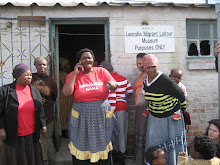
Tembisile Madyihi talks to residents of the previously Corobrik Hostel (now belonging to the City of Cape Town along with the others after the Hostels-to-Homes housing project). Photograph: Noeleen Murray, 22 April 2010.
The long hostel block, now named 'Block 1', is similar in character to the rest of the hostel units but is identifiable by an ablution block at the northern end of the hostel row which, according to Madyihi, was added by Corobrik for their workers. Other workers in the old hostel compounds were forced to share ablution blocks and this was the only accommodation with its own facilities.

View of Block 1 from the South, the hostel is subtly different to the others with different windows and is slightly shorter. Photograph: Noeleen Murray, 22 April 2010.

The characteristic ablution block added by Corobrik for their workers at what is now Block 1. Photograph Noeleen Murray, 22 April 2010.

One of the old ablution blocks near Hostel 33, now used as premises for a welding business, since bathrooms were built as part of the Hostels-to-Homes Project. Photograph: Noeleen Murray, 22 April 2010.
For the rest of Lwandle's hostel dwellers communal ablution blocks were 'separate shower blocks for every four hostel buildings' (Urban Foundation Report, 1987 p.19). The report records: 'c) Dissatisfaction with the ablution facilities: Hot water is only available between 3.30am and 5.ooam, and nothing for the rest of the day.' (Urban Foundation Report, 1987, p.26). In thinking about this, we considered the difficulties of being a labourer returning from a hard day of manual work and only being able to take a cold shower in the evenings.
From talking to current residents of Block 1 it appears that some of them were labourers employed by Corobrik and the Museum will be visiting them to record their stories as part of the on-going research into hostel life at Lwandle.





This is interesting. I wonder when it was built in relation to the other hostels. Also then I would assume that the long corrugated iron building which is now called "The Mall" in Lwandle was the Gants Hostel. Gants had a large food processing factory in Somerset West. Lundi Mama and others photographers from Lwandle took some wonderful photographs of the interior of "The Mall" about a month ago and i suspect that it resembles some of the living spaces in the other hostels in the 1980s.
ReplyDeleteFrom the plans displayed in the Museum from the 1950s, it looks like it was part of the original set of parallel blocks, the first one to the western side of Hostel 33 in the same set of rows. The abultion block on the end however appears as an addition, and the new, larger windows were probably an improvement that Corobrik made for their workers once they had acquired the building. I think that you are correct about the Gants building (well its a prefab really)which is in fact made from asbestos. The corrugated iron buildings now house a creche and were orginally constructed as a clinic, I think. There is much to check!
ReplyDelete